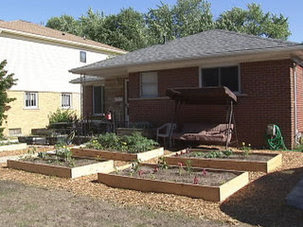I started to respond in the comment section to several questions from Barefeet in the Kitchen and then decided my response was getting a bit long-winded for that venue.
2. Pulled out the plants that were near death and those should not be thrown in the compost pile because the fungus can survive unless subjected to intense heat. (Which means it might die in the valley but you'd be taking a chance.)We chose to leave
3. Next year, plant resistant varieties or ones that have shown resistance this year. One of the heirlooms, Chico, looks lush and healthy despite being in a bed where even the Early Girls are suffering.
Here are some helpful excerpts from our Web searches ~
Fusarium wilt and Fusarium crown rot symptoms begin as yellowing of older leaves. With Fusarium crown rot, the leaves often turn brown or black and eventually wilt. With Fusarium wilt, the yellow leaves turn downward and droop.Fusarium oxysporum, the cause of both diseases, is a common tomato fungus that lives in the plant's vascular system, which carries water from the roots to the leaves. To see if either of these diseases is present:
- Check watering practices. Both over- and underwatering can mimic disease symptoms.
- Check the roots. Discolored roots indicate root rot.
- Cut the lower or main stem and look inside at the vascular tissue. Fusarium wilt causes a dark brown discoloration within the vascular tissue. Fusarium crown rot causes a rot or canker at the base of the stem and possibly a root rot. (We found when we cut open the stems of infected plants the entire diameter was brown.)
Most tomato seeds or transplants are labeled with a code such as "VFN," "VFNA," "VFNT," etc. This indicates that the plants are resistant to Verticillium wilt (V), Fusarium wilt (F), southern root-knot nematode (N), early blight (A), or tobacco (tomato) mosaic virus (T). Do not plant tomatoes, potatoes or eggplant in the affected area for two or three years.
And on another site~
The first line of defense against wilt is to use disease-free seedlings. This avoids introducing wilt fungi into the garden. Remove and destroy wilted plants and all debris of tomato and other susceptible crops at the end of the growing season. Rotate tomato-growing areas, growing tomatoes in the same part of the garden only once in four years. The benefit of rotation is less with wilts than with other diseases since both wilt fungi survive for years in the soil and the Verticillium fungus attacks many different crops. Fungicides for control of leaf blights have no effect on the wilt diseases, which are internal infections. Once soil is infested and further rotation impossible, the only possible management practice is use of resistant varieties.









